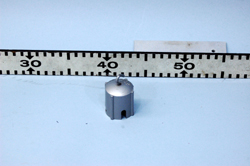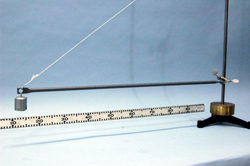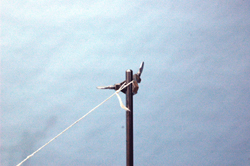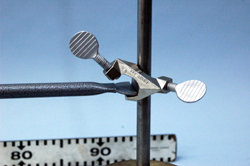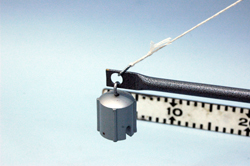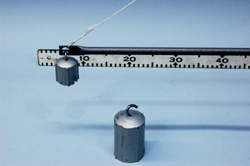Horizontal Boom, 1J30.40
Topic and Concept:
Statistics of Rigid Bodies, 1J40. Static Torque
Location:
Cabinet: Mechanic (ME)
Bay: (A6)
Shelf: #1
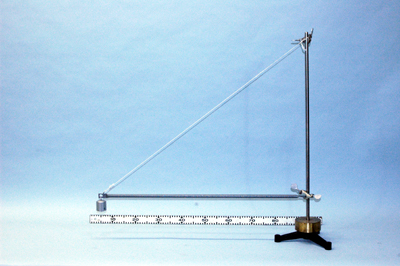
Abstract:
A 1 m rod is suspended from a vertical rod at two points: an open bracket holds one end of the 1 m rod tight to the vertical rod, allowing it to swivel, while a string tied to the vertical rod is attached to the opposite end of the 1 m rod. A weight is then hung off the far end of the now horizontal 1 m rod.
Equipment |
Location |
ID Number |
|
|
|
1 m bar with String Attached |
|
|
3/4" Rod with Clamps (table clamps not shown) |
Block & Tackle Cabinet Located Near Main Lecture Halls |
|
200 g Mass |
|
Important Setup Notes:
- N/A
Setup and Procedure:
- Mount the 3/4" rod to the lecture bench using the table clamps.
- Attach two brackets to the 3/4" rod. Space them apart about 0.5 m to start with.
- Place the dovetailed end on the lower bracket.
- Attached on the opposite end of the bar is a string with a loop on the free end. Slip this loop over the top of the 3/4" so that it rests on the top bracket as shown.
- Hang the mass from the far end of the bar.
- Adjust clamp positions so that the bar assumes a horizontal position.
Cautions, Warnings, or Safety Concerns:
- N/A
Discussion:
There are three torques acting on flagpole: that due to gravity, the tension of the string, and the normal force of the lower clamp. If we set the origin at the lower bracket, we can forget about the torque due to the normal force. Then we have the weight due to gravity acting at the center (of mass) of the rod and the tension as our forces producing torques. By shifting the top bracket up and down, we effectively change the angle at which the tension is applied. Mathematically for our static situation of a horizontal flagpole,
Tnet = 0 = T·2D·sin(θ)-Wrod·D - Wmass·2D = D(2T·sin(θ) - mrod·g - 2mmass·g)
where D is the distance to center of the rod from one end, W is the force due to gravity and θ is the angle between the rod and the string. From this we see that
T·sin(θ) = (g/2)( mrod + 2mmass·g)
We find what θ is by knowing the length of the string and the rod and imposing the condition that the rod be horizontal. Thus we determine the tension in the string.
|
|
|
|
|
|
Videos:
References:
